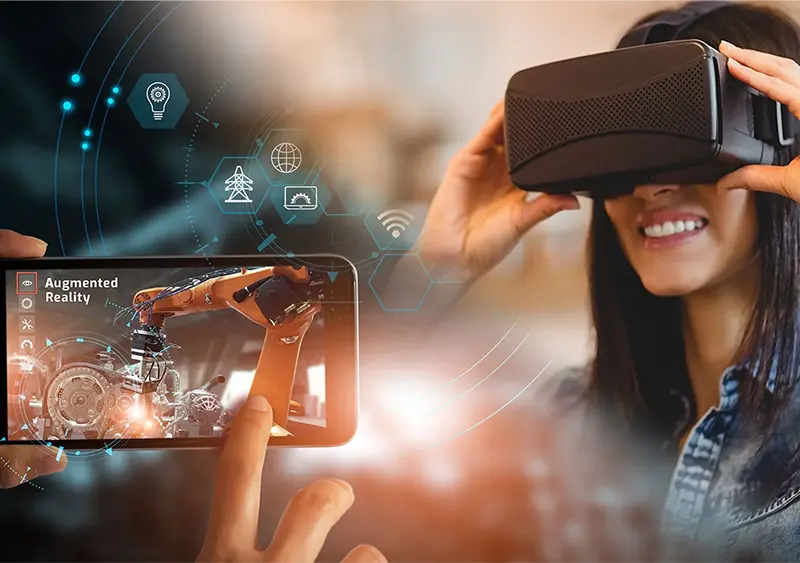AR vs VR vs XR in Learning: Which One Fits Your Training Goals?
Boost training with immersive tech — explore now!

6 MIN READ
July 28, 2025

Written By
Harish Selvaraj
The shift isn't just about digital content or smart screens. It's about turning learning into an experience. Where students don’t just watch, they walk through. Where trainees don’t just read, they react. And that shift is being powered by three key players in spatial technology.
AR, VR, and XR are no longer future concepts. They're quietly becoming tools of the present, helping learners visualize, simulate, and interact in ways traditional methods never could.
In this blog, we’ll break them down clearly, explore where each one fits best, and help you choose the right approach for your learning goals.
Understanding the Basics
What Is Augmented Reality (AR)?
AR adds digital stuff to the real world around you. For example, you point your phone at a biology book, and a 3D heart appears, beating in real-time. You’re still seeing your surroundings, just with something extra layered on top. It’s popular in classrooms because all it really needs is a smartphone or tablet. Easy to use, and pretty fun too.
What Is Virtual Reality (VR)?
VR is when you wear a headset and the real world disappears. You're suddenly inside a different place, like a factory floor or a human cell. It blocks everything else and puts you fully into the experience. You can walk, look around, and practice things like flying a plane or doing surgery. It's intense and works best for hands-on learning.
What Is Extended Reality (XR)?
XR is a bigger term that includes AR, VR, and more advanced stuff like mixed reality. It's about combining real and digital environments so they feel connected. Let’s say you're moving a virtual object on your actual desk using a headset. That’s XR. A lot of companies use XR when they want both interaction and full immersion, depending on the lesson.
Key Differences Between AR, VR, and XR in Learning
|
Aspect |
Augmented Reality (AR) |
Virtual Reality (VR) |
Extended Reality (XR) |
|
Immersion Level |
Partial. You still see your real space, just with digital overlays on top. |
Full. It replaces your surroundings entirely and pulls you into a different world. |
Flexible. Can blend the real and the virtual in one continuous learning experience. |
|
Equipment Needed |
Simple: just a smartphone or tablet. Sometimes AR glasses, but not a must. |
Needs a headset, often with controllers and sometimes sensors or cameras. |
Varies. Often combines both AR and VR tools, depending on the scenario. |
|
Best Use Case |
Ideal for visual explanations, labels, and diagrams. Think flashcards or step guidance. |
Best for skill-based or situational training where full focus is needed. |
Works great for simulations, onboarding, or advanced role-playing scenarios. |
|
Content Complexity |
Lighter content, often app-based. Easier to update and scale for multiple users. |
High. Content is 3D and interactive, usually developed in engines like Unity or Unreal. |
Advanced. Requires careful design to integrate both physical and digital interactions. |
|
Cost and Scalability |
Cheaper to create and scale across teams. |
More expensive up front due to hardware and development needs. |
Can be costly, but offers long-term value if used across multiple learning paths. |
|
Learning Experience |
Good for layered information, live support, or visual cues on real objects. |
Great for practicing risky, rare, or complex tasks in a safe environment. |
Powerful for blended experiences and long-form interactive training sessions. |
Real-World Applications in Education & Training
AR in Classrooms
In classrooms, AR feels like a quiet revolution. No big setups, no bulky gear, just a phone or tablet doing clever things. Students can point their device at a page and watch a volcano erupt in 3D or rotate a DNA helix with their finger.
Some schools use AR flashcards to help with languages. Others use it to walk students through a human body model, layer by layer. It makes abstract things feel close and real, which helps learners stay engaged longer than just looking at pictures.
VR in Industrial or Medical Training
This is where VR really shines. When training needs realism but can’t afford the risks, VR steps in. A medical student can practice surgeries without touching a real patient. A factory worker can learn how to operate machines in a virtual setup that feels close to the real one.
Firefighters, pilots, nuclear plant workers VR is being used in all these places. What’s powerful is that it lets people fail safely. They can try, make mistakes, and try again without damage or danger. That kind of freedom builds confidence fast.
XR for Enterprise Learning
Big companies are starting to invest in XR not just for training, but also for onboarding, soft skills, and leadership development. Let’s say a new employee joins remotely. With XR, they could get a virtual tour of the office, meet avatars of team members, or even practice customer conversations in a simulated space.
It’s not just about flashy tech. XR is solving real problems for global teams helping everyone learn the same thing in the same way, no matter where they are. The flexibility to combine AR moments, full VR scenes, and real-time interaction is what makes XR a long-term bet.
Which Is Right for Your Learning Goals?
Choosing Based on Learning Outcomes
Start with what you want learners to actually do after the training. If the goal is to help them recognize things or understand concepts better, AR might be enough. It’s light, fast, and easy to roll out. For a deeper dive into how AR and VR work and differ, check out our AR vs VR explained guide.
But if the skill needs practice, like flying a drone, operating a crane, or performing a surgery, then VR makes more sense. It gives the learner full control inside a safe simulation where they can repeat things as many times as needed.
When both knowledge and practice matter, XR steps in. It creates learning paths that go from theory to hands-on in one experience.
Consider Your Team’s Budget and Technical Resources
Let’s be honest. Every project has limits. AR is the most affordable to develop and scale, especially when learners already have smartphones. You can build it fast and use it anywhere.
VR needs more investment. The headsets, content creation, updates all add up. But the value it brings in high-risk or skill-heavy roles is worth it.
XR requires long-term thinking. It takes more planning, more setup, and strong technical support. If you're building a future-ready training ecosystem, XR is often the right call.
Future Trends: Where It’s All Going
The lines between AR, VR, and XR are starting to blur. Platforms are improving and switching between modes more easily. AI is joining in too, making content smarter and more interactive.If you’re curious how these technologies are already transforming industries, explore the impact of AR and VR on eCommerce.
Soon, it won't be about picking just one tool. The future of learning will likely use all three together to create seamless, adaptive experiences that actually stick
Conclusion
Choosing between AR, VR, and XR is not about going for the fanciest tool. It's more about understanding what your learners actually need. Some just need a visual nudge. Others need a space where they can practice without pressure. And sometimes, the answer is a bit of both.
These tools are now easier to access than ever. Whether you're teaching students, training factory teams, or onboarding new hires, immersive tech can make the process clearer, faster, and more enjoyable.
You’re not replacing teachers or instructors. You're giving them stronger tools that help people learn by doing, not just by reading or listening.
And if you’re ready to explore how this can work for your business, the right team can help turn that idea into a working solution.
Looking for XR Learning Service? ZealousXR is India's leading 3D product rendering company, specializing in high-end 3D rendering, animations, and immersive experiences. We cater to industries that demand precision, creativity, and innovation.
About the writer :
Harish Selvaraj heads Zealous Services' 3D animation and modeling projects, bringing over 17 years of experience in ... delivering top-tier 3D solutions. He collaborates directly with clients to ensure their ideas are transformed into powerful 3D results that meet both creative and business goals. Harish is deeply involved in driving sales and managing teams, making sure that each project delivers on quality while helping businesses grow through impactful 3D designs.
Read MoreFrequently Asked Questions (FAQ)
What is the main difference between AR, VR, and XR?
AR adds digital visuals to the real world using devices like phones or tablets. VR creates a fully virtual space you enter with a headset. XR is a broader term that includes both and allows mixing real and virtual elements together in one experience.
Which is more affordable for schools or small businesses?
AR is usually the most affordable. It works on smartphones and tablets, so you don't need extra hardware. It's a good starting point for visual learning without a big budget.
Is VR suitable for all kinds of training?
Not really. VR works best for hands-on or high-risk training, like medical procedures or equipment handling. It may not be needed for simple lessons or theory-based learning.
How do I know if my organization is ready for XR?
Start by looking at your learning goals and how tech-friendly your team is. If you're planning long-term training programs and want to mix real-world content with immersive practice, XR can be a strong fit. You might also need some expert help to set it up right.
Can these technologies be used for remote learning?
Yes. AR, VR, and XR are all being used in remote training setups. VR and XR are great for simulating spaces when learners can’t be onsite, while AR works well with mobile-based learning from anywhere.